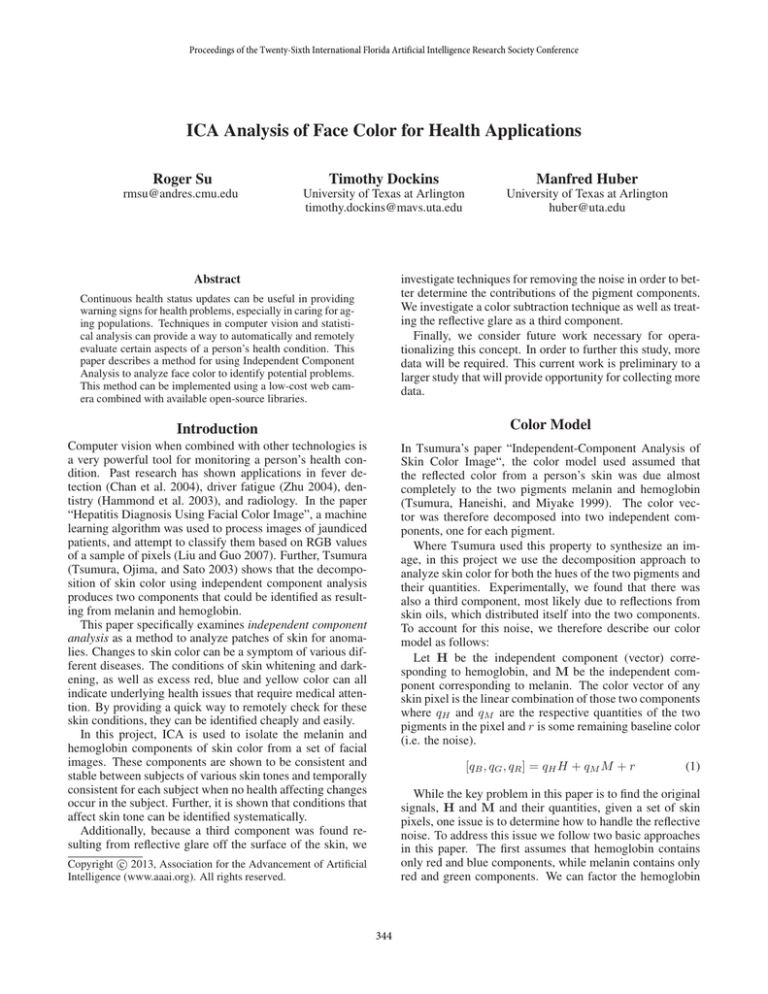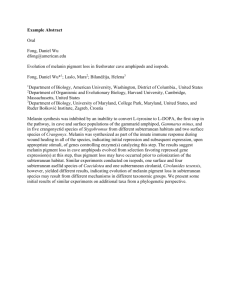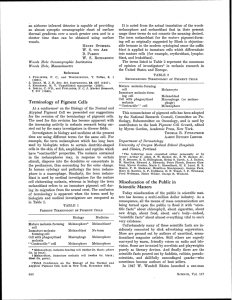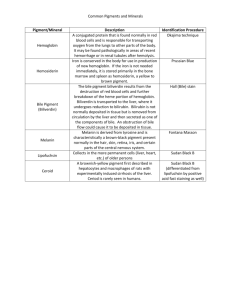
Proceedings of the Twenty-Sixth International Florida Artificial Intelligence Research Society Conference
ICA Analysis of Face Color for Health Applications
Roger Su
Timothy Dockins
Manfred Huber
rmsu@andres.cmu.edu
University of Texas at Arlington
timothy.dockins@mavs.uta.edu
University of Texas at Arlington
huber@uta.edu
Abstract
investigate techniques for removing the noise in order to better determine the contributions of the pigment components.
We investigate a color subtraction technique as well as treating the reflective glare as a third component.
Finally, we consider future work necessary for operationalizing this concept. In order to further this study, more
data will be required. This current work is preliminary to a
larger study that will provide opportunity for collecting more
data.
Continuous health status updates can be useful in providing
warning signs for health problems, especially in caring for aging populations. Techniques in computer vision and statistical analysis can provide a way to automatically and remotely
evaluate certain aspects of a person’s health condition. This
paper describes a method for using Independent Component
Analysis to analyze face color to identify potential problems.
This method can be implemented using a low-cost web camera combined with available open-source libraries.
Introduction
Color Model
Computer vision when combined with other technologies is
a very powerful tool for monitoring a person’s health condition. Past research has shown applications in fever detection (Chan et al. 2004), driver fatigue (Zhu 2004), dentistry (Hammond et al. 2003), and radiology. In the paper
“Hepatitis Diagnosis Using Facial Color Image”, a machine
learning algorithm was used to process images of jaundiced
patients, and attempt to classify them based on RGB values
of a sample of pixels (Liu and Guo 2007). Further, Tsumura
(Tsumura, Ojima, and Sato 2003) shows that the decomposition of skin color using independent component analysis
produces two components that could be identified as resulting from melanin and hemoglobin.
This paper specifically examines independent component
analysis as a method to analyze patches of skin for anomalies. Changes to skin color can be a symptom of various different diseases. The conditions of skin whitening and darkening, as well as excess red, blue and yellow color can all
indicate underlying health issues that require medical attention. By providing a quick way to remotely check for these
skin conditions, they can be identified cheaply and easily.
In this project, ICA is used to isolate the melanin and
hemoglobin components of skin color from a set of facial
images. These components are shown to be consistent and
stable between subjects of various skin tones and temporally
consistent for each subject when no health affecting changes
occur in the subject. Further, it is shown that conditions that
affect skin tone can be identified systematically.
Additionally, because a third component was found resulting from reflective glare off the surface of the skin, we
In Tsumura’s paper “Independent-Component Analysis of
Skin Color Image“, the color model used assumed that
the reflected color from a person’s skin was due almost
completely to the two pigments melanin and hemoglobin
(Tsumura, Haneishi, and Miyake 1999). The color vector was therefore decomposed into two independent components, one for each pigment.
Where Tsumura used this property to synthesize an image, in this project we use the decomposition approach to
analyze skin color for both the hues of the two pigments and
their quantities. Experimentally, we found that there was
also a third component, most likely due to reflections from
skin oils, which distributed itself into the two components.
To account for this noise, we therefore describe our color
model as follows:
Let H be the independent component (vector) corresponding to hemoglobin, and M be the independent component corresponding to melanin. The color vector of any
skin pixel is the linear combination of those two components
where qH and qM are the respective quantities of the two
pigments in the pixel and r is some remaining baseline color
(i.e. the noise).
[qB , qG , qR ] = qH H + qM M + r
(1)
While the key problem in this paper is to find the original
signals, H and M and their quantities, given a set of skin
pixels, one issue is to determine how to handle the reflective
noise. To address this issue we follow two basic approaches
in this paper. The first assumes that hemoglobin contains
only red and blue components, while melanin contains only
red and green components. We can factor the hemoglobin
c 2013, Association for the Advancement of Artificial
Copyright Intelligence (www.aaai.org). All rights reserved.
344
and melanin vectors into two equations.
H = [qB , 0, qR ] + rH [1, 1, 1]
M = [0, qG , qR ] + rM [1, 1, 1]
(2)
(3)
where [1, 1, 1] is the gray part of the independent component due to reflection of the white background lighting, and
rH and rM are scalars which represents how much white is
attributed to each independent component.
This decomposition is supported by the data samples
gathered over a period of a few weeks. While the actual
color vectors varied significantly even with measurements
taken minutes apart, the hue stayed fairly constant, suggesting that when the effects of glare are taken out, the color vectors do not vary significantly. However, this scheme might
turn out to be not completely applicable in the case of unusual melanin or hemoglobin components and might result
eventually in the missing of change indicators.
To address this, our second approach we treat glare as an
additional component and follow a basic paradigm where
this noise component is identified based on the best reproduction of the overall color pixel distribution. Here we rely
on the assumption that the variation between pictures taken
in close proximity will likely be largely caused by changes in
glare (i.e. noise) and not in the hemoglobin and the melanin
components. To further investigate this we propose in our
future work to enhance this effect by varying illumination
parameters and thus explicitly causing changes in the distribution of the glare component.
Figure 1: Process overview
Effects from Disease
Using the color model described, variations in skin color resulting from disease can be separated into two categories:
Data acquisition: This part of the process addresses image capture and representation. Capture is generally a matter
of implementation. Once an image is captured and the appropriate pixels are identified, these samples are stored as
n × 3 matrices for n pixels.
Primary signal separation: The process of separating the
primary signals from the mixed signals is accomplished by
independent component analysis. The result is two component that are statistically independent. These components
are key elements of the overall analysis.
Noise separation: Experimentation shows that there is a
white component resulting from reflection on the surface of
the skin. This noise must be separated from the two components. This is accomplished using one of the two proposed
methods, either assuming zero blue and green components
for melanin and hemoglobin, respectively, or by finding the
minimum of the variance of their mean ratio across three
images assuming varying glare components.
Hue analysis: The resulting vectors can be used to find the
hue angle. This is done separately for each pigment component.
Source quantification: Once noise has been handled and
the independent component stabilized, the contribution of
each pigment to the resulting image can then be found. We
use the pseudoinverse of the matrix formed from the independent components, applied to each pixel, to find the mean
quantities of the pigments contributing to the overall color.
• Color vector: yellowing, blueness
• Color quantities: paleness, flushing, darkening
In the first case, we would expect yellow and blue to be absorbed into either the melanin vector, hemoglobin vector, or
some of both. In the second case, we would expect the quantities of hemoglobin and melanin to change, but the color
vectors should remain mostly the same.
Methodology
The goal of this paper is to describe a technique for determining the hue of the two aforementioned pigments and to
determine the contribution of each pigment to the resulting
color. As the contributing distribution of each pigment is
unknown, the first challenge is to separate the two pigments
from the given image. The next challenge is to remove the
effects of noise. Then, we can proceed by analyzing hue
and the quantities. The process is shown in Figure 1 and is
summarized as follows:
1. data acquisition
2. primary signal separation
3. noise separation
4. hue analysis
5. source quantification
345
Independent Component Analysis
as follows:
As a generative latent variable model, independent component analysis, gives a representation of multivariate data
with non-Gaussian latent variable distribution. Because we
cannot assume that the image data is normally distributed,
this approach is preferred over principal component analysis
which only guarantees linear independence if the latent variables have joint Normal distribution. ICA assumes that the
distribution of the latent variables is non-Gaussian and uses
that to find independence in the components. Summarily,
the ICA algorithm finds a representation of data such that the
linear independence of the individual components is maximized. This property addresses this paper’s central problem
of blind source separation. The Cocktail-party problem is a
classic example of the signal separation problem and is described in (Hyvärinen and Oja 2000). In this present work,
signal separation and ICA relate to the problem of determining the mixture of pigment contributions to the color of a
patch of skin.
In the given color model, we have assumed that the color
of the skin is a linear mixture of two sources (melanin and
hemoglobin) (Tsumura, Haneishi, and Miyake 1999). See
Equation (1) above. Given that, we consider each pixel in
an image of a subject’s skin as a set of n linear mixtures
x = x1 , ..., xn of two independent components.
The task here is to recover the original signals sn for both
pigment contributions. As described in the color model,
we assume noise in the signals from residual articles (e.g.
glares, oil on the skin, etc.). For the sake of discussion, we
approach the noise separately and show the simple case of
ICA. In matrix form, this is shown in Equation (4) where
x is the mixture vector (the pixel in our problem), s is the
original signal vector (hemoglobin and melanin), and A is
the mixing matrix.
x = As
for R ≥ G ≥ B, h = 60 ∗ (G − B)/(R − B)
for G > R ≥ B, h = 60 ∗ (2 − (R − B)/(G − B))
for G ≥ B > R, h = 60 ∗ (2 + (B − R)/(G − R))
for B > G > R, h = 60 ∗ (4 − (G − R)/(B − R))
for B > R ≥ G, h = 60 ∗ (4 − (R − G)/(B − G))
for R ≥ B > G, h = 60 ∗ (6 − (B − G)/(R − G))
In practice, we found that the hue angles for these pigments for most people under normal conditions were ≈ 60
for melanin, and ≈ 330 for hemoglobin. Variances in apparent skin color are accounted for in the quantity/saturation of
the pigments.
Experimentation shows that when the lighting conditions
is held relatively constant, the hues remain extremely stable,
suggesting that if images are taken over time in the same
location, variations in hue will be fairly easy to detect. This
can be expected to remain the case even accounting for
noise as long as the noise is consistent.
Source Quantification
In order to determine the ratio of quantities of the two components, the Moore-Penrose pseudoinverse (using Singular
Value Decomposition) of each component is found. This inverse is applied to each pixel in the original image to get the
average quantities of the independent components. These
averages are normalized as follows:
Let q̂H and q̂M be the average quantities of the
hemoglobin unit vector and melanin unit vector. It is possible that some of the qH and qM are negative, in which case
we shift the entire distribution so all points have positive qH
and qM . In this way, we estimate the residual color and shift
the distribution to minimize its effect.
We assume there is a point with lowest melanin, and one
with lowest hemoglobin that we can use as a baseline. By
shifting the distribution such as to make these points have
positive quantities, we can now look at the ratio of qH and
qM .
We can interpret this ratio as the number of units of qH
which appear with an additional unit of qM , and use this to
identify the health conditions which could cause an excess
or a lack of the quantities of hemoglobin or melanin.
(4)
In general, several techniques are available to solve for the
source signals (Comon 1994). In principle, these methods
seek a matrix W, as the inverse of the estimation of matrix
A, such that each s is independent:
s = Wx
(5)
As implemented in this work, for each image captured, a set
of n pixels is stored as an n × 3 matrix, where each pixel
is represented as [qB , qG , qR ], with 0 ≤ qB , qG , qR ≤ 255.
The FastICA algorithm (Hyvärinen and Oja 2000) is then
used to acquire sets of independent components, two based
on each image.
Because ICA does not provide an ordering for the components returned, each independent component is matched
against prototype components for hemoglobin and melanin
and labeled as such.
MB
HB
MG
HG
MR
HR
Handling the white component
Because there is an uneven distribution of reflection in
hemoglobin and melanin, we must find the amount of that
noise in each of the components individually. This uneven
distribution is caused by physical arrangement of the two
pigments in the skin. Melanin is situated in the epidermis,
closer to the surface of the skin, while hemoglobin is predominant in the dermis.
To determine the amount of white distributed into each
component, we propose two approaches here. In the first
the noise is determined by subtraction assuming that the
melanin and hemoglobing components have zero blue and
green components, respectively. In the second, we only assume the components to be stable and that the noise will
(6)
Analysis of color vectors
To analyze the color vectors, the hue angle (see Preucil’s
color circle (Preucil 1953)) is calculated for each component
346
Experimentation
have some variance across the three acquired images. The
key task is then finding the quantities of white noise in the
other components that best explains the variance. These are
expressed as qH and qM in Equation (1).
This can be accomplished by finding the minimum variance of the ratio of the mean quantities of the components
across the acquired images with respect to qH and qM . A
brute force method of iterating through a range of values for
each components is used. Starting from base values, white is
added back to each component individually and the variance
across images found.
Two forms of experimentation were performed. The first set
utilized static images of people with known health conditions. The second set were captured live from an inexpensive web camera mounted behind a two-way mirror.
Static images
Changes to the color vector We performed tests on static
images of patients with two conditions known to affect skin
color; Argyria and Gilbert’s syndrome.
Argyria is a skin condition caused by exposure to silver in
which the skin turns blue-gray. An image of an Argyria patient from a news website was analyzed and compared to that
of the same patient before the silver exposure. We would
expect to see this blue-gray component absorbed into either
hemoglobin or melanin, changing the color vector.
Separating out quantity by subtraction If we assume
that melanin only contains green and red components, and
hemoglobin only contains blue and red, we can just subtract
out some quantity of color such that the melanin has no blue
component left, and that the hemoglobin has no green component left. Then, we can calculate the pseudoinverse and
proceed with taking the ratio of the two quantities.
Therefore an independent melanin component
[MB , MG , MR ] becomes [0, MG − qB , MR − qB ],
and in the vast majority of cases, MG > MB and
MR > MB so the component is still positive. Similarly,
the independent hemoglobin component [HB , HG , HR ]
becomes [HB − qG , 0, HR − qG ], and once again the
component was usually positive. The resulting matrix to
perform pseudoinverse on becomes
0
MG MR
HB
0
HR
MG
HG
1
MR
HR
1
Jaundice
60
240
60
330
330
120
Hemoglobin
Table 1: Example changes in hue
Gilbert’s Syndrome causes jaundice in sufferers from excess bilirubin produced in the blood. Bilirubin is a yellow
product, and therefore the skin condition of jaundice is characterized by excess yellow component in skin color. We
would expect to see yellow absorbed into one of the independent components, changing the angle of the color vector.
Static images of patients with these conditions were analyzed. The resulting hues indicated a significant change in
the color vector of individual components. Table 1 shows
the results of these color changes with respect to a subject in
normal conditions.
Separating out as a third component If we assume that
reflections are a component, we can pass a [1, 1, 1] along
with our two independent components before calculating the
pseudoinverse. This may introduce new error, since ICA
was run on the points with the assumption that there were
only two independent components . In this case, the resulting matrix becomes:
MB
HB
1
Argyria
Melanin
where MG and MR are the green and red components of
melanin with B subtracted, and HB and HR are the blue
and red components of hemoglobin with G subtracted.
"
Normal
Changes to color quantity Changes to the quantity of the
colors are less straightforward to interpret. Since the independent components contain some amount of reflected
light, this could affect the quantity of the vectors. Since
the color model assumes that reflections are uniformly distributed over the face, the two components should contain
equal amounts of white vector.
For subjects with similar lighting and color vectors, the
hemoglobin/melanin ratio values can be used as a measure
of redness. In the following sample images, one normal and
the other flushed, the ratio increased from 1.1 to 1.2.
#
Both of these methods were tried, and results were mixed.
Although it appeared that in most cases flushing and paleness were reflected in the ratios, the quantities’ variance
from a live feed was quite large, suggesting that some
other method should be used to stabilize the quantities. In
(Tsumura, Haneishi, and Miyake 1999), reflections were not
factored into the two components, and it was noted that
when more pigment was added, the amount of reflection
also increased. To make the third component method more
robust we propose to use active lighting variations to increase the glare variance without affecting the melanin and
hemoglobin components.
(a) Normal
skin
(b)
Flushed
skin
Figure 2: Static images of skin patches
347
Live capture
vectors and quantities across multiple days. It contained images for seven (7) subjects. For each subject, three images
were taken daily over a period of five (5) days. These images were taken at different times of the day and at different physical stances naturally. We expect there to have been
some variation in noise resulting from slight differences in
ambient lighting.
A second set contained images of five (5) subjects. For
each subject, three baseline images were taken. Then, attempting to induce a flushness by raising heart rate, each
subject exercised for some period. Three more images were
then taken of each subject.
Skin patch acquisition In this project, when sampling
from a live feed, pixels were taken from both cheeks of the
user’s face to provide the data points for ICA. Using the
cheeks to provide the pixels to be analyzed can guarantee
a consistent and unobstructed patch of skin in subsequent
trials. There are many face detection algorithms which can
be used to get a bounding box for the cheeks. We used Viola and Jones’ (Viola and Jones 2004) method of Haar Cascades to identify the mouth and eyes, and then the cheek
boxes were estimated from these bounding boxes as shown
in figure 3.
The cheeks are assumed to be a rectangle of the same
width as the eyes, extending to touch the top of the mouth.
The middle of the cheek was taken to avoid overlap with the
background or parts of the nose.
In this way, objects like glasses or hair which can distort
the distribution of the pixels are kept out of the skin patch.
For our experiments, around 2000 pixels were captured for
each sample.
Results in color vector and quantity From images captured across five separate days, these images containing
slight variations in ambient lighting and shading, the independent components maintained consistent across the images. The hue resulting from the color vector of each component, therefore, remained the same across days at melanin
≈ 60, hemoglobin ≈ 330.
On the other hand, the average quantities that each pigment contributed to the resulting pixels varied from dayto-day for each subject and also between subjects. Table
2 shows the standard deviations for each subject.
subject
1
2
3
4
5
6
7
standard deviation
0.22
0.12
0.13
0.62
0.29
0.46
0.81
Table 2: Standard deviations across days
The standard deviation of the ratio of quantities across all
individuals for the given five days was σ ≈ 0.52. In the second data set, the components stayed similarly constant while
the quantities seemed to indicate a systematic hemoglobin
increase for the flushed condition. However, the differences
proved not to be statistically significant across baseline and
flushed images in the second set (σ ≈ 0.06). This could
be due to the incomplete noise removal or the relatively low
level of exercise that was used in the experiment.
Results in removing the white component Because the
three images captured from a live subjects were taken moments apart, there was little change in the lighting on the
subject’s face between the images. This was indicated in
no detectible difference in the variances of the component
quantity ratios between the three images. While we assume
there to be some variance, such difference may have been
too small for the precision used in the calculation.
Figure 3: Sample bounding boxes
Conclusion
Image sets Two sets of images were acquired and analyzed from an inexpensive web-camera mounted behind a
two-way bathroom mirror with a uniform lighting system.
The purpose of the first set was to show stability in color
Using ICA to separate out the hemoglobin and melanin components of a person’s complexion may be a fairly simple way
to check on the health of a person. These measurements can
348
Other areas of the light spectrum
be taken at home with relatively inexpensive equipment and
the algorithms involved are fairly common and implemented
by multiple open source libraries.
When running this analysis on static images, we found
that the hue angles of the two components were overall very
stable for repeated samples of the same person, and were
sensitive to changes in the color vectors brought on by discoloration of the skin due to disease.
The quantities obtained by taking the pseudoinverse of the
two components were moderately stable, but error was introduced into the measurement by the presence of reflections.
Various methods of compensating for the reflections gave
mixed results for improving the stability of the quantities.
For analysis on images taken by a web-camera, hue angles continued to exhibit the same stability. This is expected
behavior. Quantities, however, varied across subjects and
across days for the same subjects. This may be an effect
of the image acquisition process as no control accounted for
lighting, pose in relation to the camera, nor for the physical
condition of the subjects. It is interesting to note that the
ratios did change in the same direction, however insignificantly, between baseline and flushed images. This matches
with the result in the static image.
These results indicate that it is possible to detect changes
in hue and in the ratio of the quantities of each component.
While experimental data may not support the stabilization
of the two pigment components, the methodology is fundamentally sound. As such, we have shown that independent
component analysis is a viable method for decomposing images of skin into a usable data set for monitoring skin tone
and, ultimately, the health of a given subject.
Finally, infrared photography may provide a third dimension
of information which could be integrated with the previous
results. The amount of reflectivity, which increased error for
our measurements, could also be analyzed for details about
how oily the user’s skin is or the presence of perspiration
present.
Acknowledgments
This material is based upon work supported by the National
Science Foundation under Grants CNS-0649229 and CNS1157061.
References
Chan, L.-S.; Cheung, G. T. Y.; Lauder, I. J.; and Kumana,
C. R. 2004. Screening for fever by remote-sensing infrared thermographic camera. Journal of travel medicine
11(5):273–9.
Comon, P. 1994. Independent component analysis, A new
concept? Signal Processing 36(3):287–314.
Hammond, P.; Hutton, T.; Maheswaran, S.; and Modgil, S.
2003. Computational Models of Oral and Craniofacial Development, Growth, and Repair. Advances in Dental Research 17(1):61–64.
Hyvärinen, a., and Oja, E. 2000. Independent component
analysis: algorithms and applications. Neural networks : the
official journal of the International Neural Network Society
13(4-5):411–30.
Liu, M., and Guo, Z. 2007. Hepatitis diagnosis using facial
color image. Medical Biometrics 160–167.
Preucil, F. 1953. Color hue and ink transfer. Their Relation
to.
Tsumura, N.; Haneishi, H.; and Miyake, Y.
1999.
Independent-component analysis of skin color image. Journal of the Optical Society of America. A, Optics, image science, and vision 16(9):2169–76.
Tsumura, N.; Ojima, N.; and Sato, K. 2003. Imagebased skin color and texture analysis/synthesis by extracting hemoglobin and melanin information in the skin. ACM
Transactions on . . . 770–779.
Viola, P., and Jones, M. 2004. Robust real-time face detection. International journal of computer vision 57(2):137–
154.
Zhu, Z. 2004. Real time and non-intrusive driver fatigue
monitoring. Proceedings. The 7th International IEEE Conference on Intelligent Transportation Systems (IEEE Cat.
No.04TH8749) 657–662.
Further Work
Automation
For use in a live scenario within a home or apartment, image
capture and processing will need to be automated. To automate image capture, facial recognition will be introduced so
that trends for individuals may be recorded. For processing,
a statistical distribution could be associated with the past and
present hues of a user’s face, and deviations could be calculated automatically. Machine learning algorithms have been
shown to be effective in estimating the progression of the underlying disease based on how jaundiced the skin color was,
and their use could be extended to cover not only changes in
the color component, but also the quantities of each component. Trends over time could be observed, and estimations
could be made about which deviations were significant, and
which reflected everyday variability.
Variance in lighting
Future work also will need to address the normalization of
the two color vectors to take into account the uneven distribution of the reflection (white) color vector between the
two independent components. One method to be explored
is systematically inducing variation in the distribution of the
lighting between the three images. LED lighting can be easily controlled programmatically and synchronized with the
image capture process.
349







